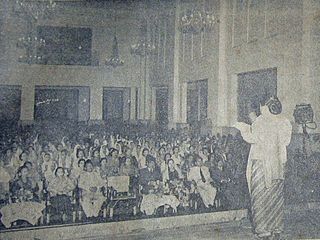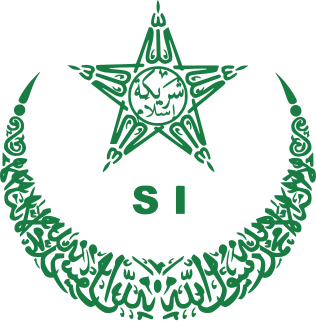Related Research Articles

The Communist Party of Indonesia was a communist party in Indonesia during the mid-20th century. It was the largest non-ruling communist party in the world before its brutal and violent eradication in 1965 and ban the following year. The party had two million members in the 1955 elections, with 16 percent of the national vote and almost 30 percent of the vote in East Java. During most of the period immediately following independence until the eradication of the PKI in 1965, it was a legal party operating openly in the country.

Gerwani was a women's organization founded as Gerwis in Semarang, Central Java, on 4 June 1950.

Sarekat Islam or Syarikat Islam was an Indonesian socio-political organization founded at the beginning of the 20th Century during the Dutch colonial era. Initially, SI served as a cooperative of Muslim Javanese batik traders to compete with the Chinese-Indonesian big traders. From there, SI rapidly evolved into a nationalist political organization that demanded self-governance against the Dutch colonial regime and gained wide popular support. SI was especially active during the 1910s and the early 1920s. By 1916, it claimed 80 branches with a total membership of around 350,000.

Raden Mas Hadji Oemar Said Tjokroaminoto, better known in Indonesia as H.O.S. Tjokroaminoto, was an Indonesian nationalist. He became one of the leaders of the Islamic Trade Union, founded by Samanhudi, which became Sarekat Islam, which they both co-founded.

Islamic Association Party of Indonesia was an Islamic political party in Indonesia. In 1973 it was merged into the United Development Party.
Kongres Buruh Seluruh Indonesia was a trade union centre in Indonesia. It was politically linked to the Socialist Party of Indonesia (PSI). KBSI was founded in 1952, in an attempt from the socialists to counter the influence of the PKI-led SOBSI trade union centre.
The Consultative Body of Political Parties was a loose coalition of political parties in Indonesia. A preparatory meeting, which would lead to the formation of BPP, was held on 27 February 1951. The BPP was officially launched on March 31, 1951, and a Common Programme adopted. The BPP Common Programme was broadly nationalist. It called for an independent Indonesian foreign policy, and a break from the Round Table Conference agreement. Moreover, it called for the lifting of the state of War, nationalization of key industries, release of political prisoners, land reform, the right to strike, swift holding of elections and the return of West Irian to Indonesia.
Sentral Organisasi Buruh Republik Indonesia was an Indonesian trade union centre. SOBRI was founded in Bandung in 1951. SOBRI functioned as the trade union wing of the Murba Party.
Sarbupri, short for Sarekat Buruh Perkebunan Republik Indonesia, was a trade union of plantation estate workers in Indonesia. As of the late 1950s, it was the largest trade union in the country. Sarbupri was affiliated to the trade union centre SOBSI, which was linked to the Communist Party of Indonesia.
Sarekat Buruh Kehutanan Islam was a trade union of forest workers in Indonesia. SBKI was founded in 1965. SBKI, formed by Islamic foresters, sought to counter the influence of the communist-aligned Sarbuksi union. SBKI was affiliated with the Islamic trade union centre SARBUMUSI.
Sarbuksi, short for Sarekat Buruh Kehutanan Seluruh Indonesia, was a trade union of forest workers in Indonesia. Sarbuksi was affiliated to the trade union centre SOBSI, which was linked to the Communist Party of Indonesia. During its existence, Sarbuksi was highly influential in regards to forestry policies in Indonesia. As of January 1962, Sarbuksi claimed a membership of a quarter million.
Serbaud, short for Serikat Buruh Angkatan Udara, was a trade union of air transport employees and workers in Indonesia. Serbaud was affiliated to the trade union centre SOBSI, which was linked to the Communist Party of Indonesia. Serbaud was estimated to have less than 3,000 members.
Persatuan Buruh Kereta Api was a trade union of railway workers in Indonesia. It was affiliated with the Kongres Buruh Seluruh Indonesia (KBSI) trade union centre. PBKA was one of the key unions of KBSI. As of March 1958, PBKA claimed a membership of 32,000. PBKA was led by Dr. Kusna.
The All-Indonesian Federation of Workers'Organisations was the largest trade union federation in Indonesia. Founded during the period of the country's independence in the late 1940s, the federation grew rapidly in the 1950s. Initially formed with loose connections to the Communist Party of Indonesia (PKI) and with members from other parties, over time the PKI became dominant in the organisation. With the introduction of President Sukaro's guided democracy in the late 1950s, SOBSI was formally recognised and given a place in the national decision-making structures. In the 1960s, SOBSI came into conflict with the Army, whose officers controlled the country's state enterprises. Following the 1965 coup that subsequently produced Suharto's New Order regime, SOBSI was declared illegal, its members killed and imprisoned and most of the leadership executed.
Serbuni, short for Serikat Buruh Unilever Indonesia, was a trade union of workers at the factories of Unilever in Indonesia. During the late 1950s and early 1960s, Serbuni was the largest of the four trade unions at the Unilever factories in the country. Serbuni was affiliated to the trade union centre SOBSI, which was linked to the Communist Party of Indonesia (PKI). K. Werdojo was the general secretary of Serbuni.
Berita Film Indonesia was the first government-owned film production company of Indonesia. BFI was formally established on 6 October 1945, after the Japanese occupation army surrendered, using the same equipment and studio as the Japanese studio Nippon Eigasha. The company, under RM Soetarto and Rd Ariffien, was soon forced to leave Jakarta for Surakarta and later Yogyakarta owing to the ongoing revolution against the former Dutch colonists. After the Netherlands recognised Indonesia's independence in December 1949, BFI was merged with the Dutch-owned Regerings Film Bedrijf.
A communist front is a political organization identified as a front organization under the effective control of a communist party, the Communist International or other communist organizations. They attracted politicized individuals who were not party members but who often followed the party line and were called fellow travellers.
Serikat Buruh Daerah Autonoom was a trade union in Indonesia. SEBDA organized local government employees at the kabupaten and autonomous town level. The union was founded in June 1947. SEBDA was affiliated to the SOBSI trade union centre. As of 1956 S. Haryawisastra served as general secretary of SEBDA. As of 1957 SEBDA claimed to have 73,000 members. By May 1960 SEBDA had 82,000 members. Many of the SEBDA members were rural and/or seasonal labourers.

Bintang Merah was a magazine of the Communist Party of Indonesia which published in Jakarta from 1945 to 1948 and again from 1950 to 1965. It described itself as a magazine of Marxist-Leninist politics and theory.

Anarchism in Indonesia has its roots in the anti-colonial struggle against the Dutch Empire. It became an organized movement at the behest of Chinese anarchist immigrants, who played a key part in the development of the workers' movement in the country. The anarchist movement was suppressed, first by the Japanese occupation of Indonesia, then by the successive regimes of Sukarno and Suharto, before finally re-emerging in the 1990s.
References
- 1 2 3 Hindley, Donald. The Communist Party of Indonesia, 1951-1963 . Berkeley: University of California Press, 1964. p. 142
- 1 2 3 4 5 6 7 University of Sydney. Review of Indonesian and Malayan Affairs , Volume 19. Sydney: 1985. pp. 15-18
- ↑ Sen, Krishna. Indonesian Cinema: Framing the New Order . London u.a: Zed Books, 1994. p. 32
- ↑ Sen, Krishna. Indonesian Cinema: Framing the New Order . London u.a: Zed Books, 1994. p. 55
- ↑ Winarno, Ateng. Kamus singkatan dan akronim: baru dan lama . Yogyakarta: Penerbit Kanisius, 1990. p. 578